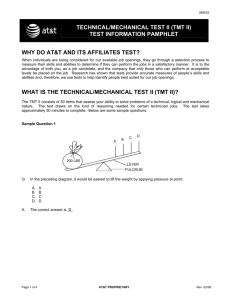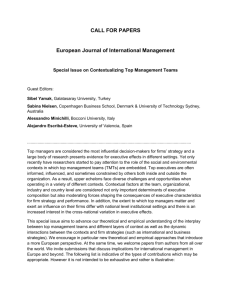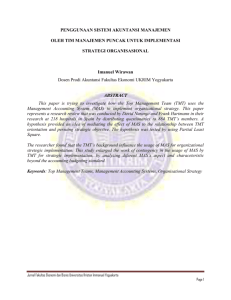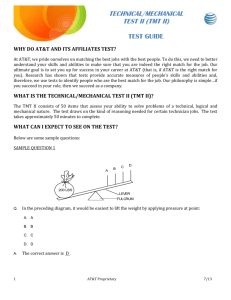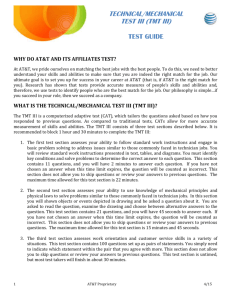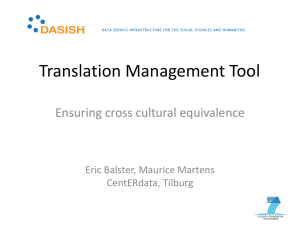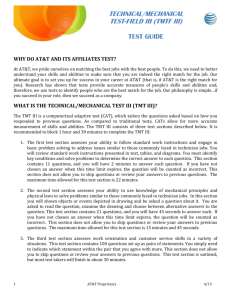CALTECH OPTICAL OBSERVATORIES OIWFS Development for TMT Caltech Instrumentation Note #604
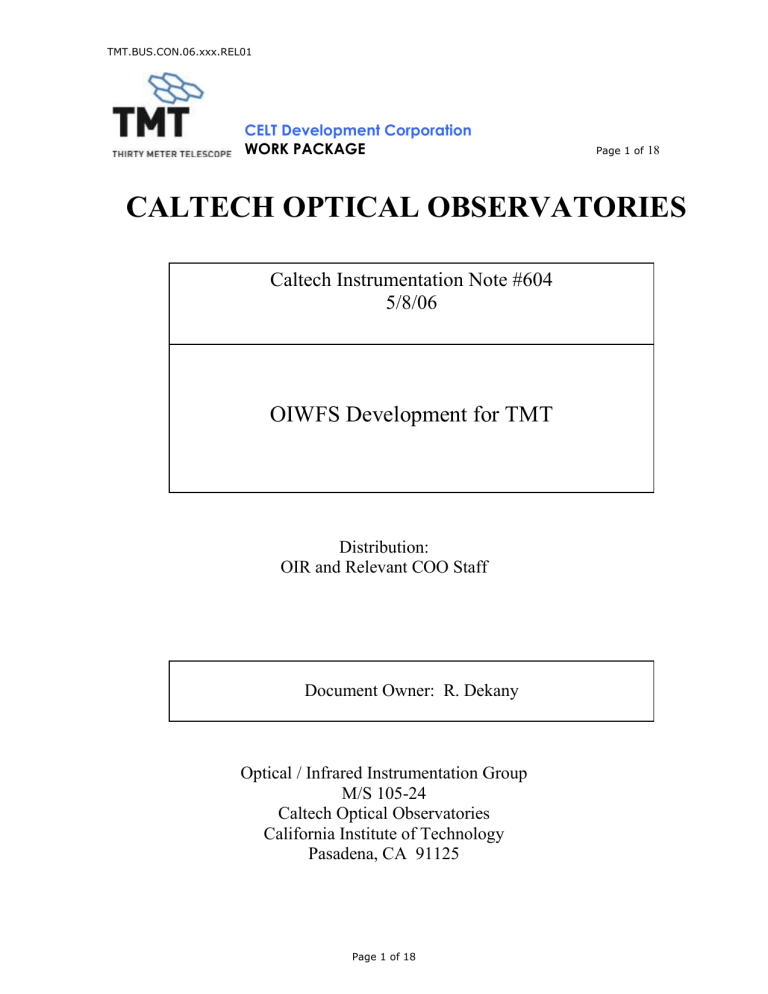
TMT.BUS.CON.06.xxx.REL01
CELT Development Corporation
WORK PACKAGE
Page 1 of 18
CALTECH OPTICAL OBSERVATORIES
Caltech Instrumentation Note #604
5/8/06
OIWFS Development for TMT
Distribution:
OIR and Relevant COO Staff
Document Owner: R. Dekany
Optical / Infrared Instrumentation Group
M/S 105-24
Caltech Optical Observatories
California Institute of Technology
Pasadena, CA 91125
Page 1 of 18
TMT.BUS.CON.06.xxx.REL01
CELT Development Corporation
WORK PACKAGE
Page 2 of 18
Title: On-Instrument Wavefront Sensor (OIWFS) Conceptual Design
Performing Institution:
Period of Performance (Total):
Period of Performance (This Period):
California Institute of Technology
30 months
June 1, 2006 – Nov 30, 2008
Work Package Manager:
TMT Project Work Package Manager:
TMT WBS Element Number(s):
Richard Dekany
Brent Ellerbroek
Introduction:
TMT.INS.AO.NFIRAOS.NGS
TMT.INS.AO.COMP.IRDET
TMT.INS.AO.EXP.EXP11
TMT.INS.AO.EXP.EXP13
Standardization of the TMT On-Instrument Wavefront Sensors (OIWFS) is a key recommendation of the NFIRAOS Conceptual Design Review Committee 1 . The committee correctly pointed out the importance of optimized OIWFS performance (in both tip/tilt (TT) and tip/tilt/focus/astigmatism (TTFA) modes) in obtaining maximum sky coverage among the NFIRAOS-fed instruments (IRIS, NIRES, and WIRC).
Furthermore, they specifically noted the operational and interface simplicity advantages of having a single, common OIWFS design for use by each of the instruments.
Caltech Optical Observatories proposes to partner with the TMT to develop a standardized, optimized OIWFS for use among all of the TMT instruments. Building on the optimal TTFA sensor development underway for Caltech's PALM-3000 precision adaptive optics system, we proposed to perform a number of trade studies investigating OIWFS performance, jointly develop Interface Control Documents
(ICDs) for both NFIRAOS and the several instrument teams, and prototype a IR
OIWFS in the laboratory.
These activities are uniquely synergistic with COO's PALM-3000 TTFA development and COO's proposed involvement in TTFA/OIWFS development for the Keck
Observatory Next Generation Adaptive Optics (NGAO) system. Caltech's unique combination of expertise in wavefront sensor development (having built now 6 wavefront sensors used at Palomar), practical experience performing scientific observations with the Palomar and Keck LGS AO systems, and detailed understanding of 'real-work' aspects of IR detector array technology (having conducted ~$1.2M of detailed investigative work for DoE's Joint Dark Energy Mission
1 "Review Committee Report on the Conceptual Design Review for NFIRAOS," N. Hubin, Chair,
TMT.XXX.COR.YY.ZZZ.REL01, March 6-7, 2006.
Page 2 of 18
TMT.BUS.CON.06.xxx.REL01
CELT Development Corporation
WORK PACKAGE
Page 3 of 18
(JDEM) / SuperNova Acceleration Probe (SNAP), makes COO incomparably suited to work with the TMT project, NFIRAOS, and instrument teams in this critical development.
Summary of Work to be Performed:
Caltech Optical Observatories OIR group will conduct OIWFS performance trade studies, develop a standardized OIWFS design and interface documentation (ICDs), and prototype an IR TTFA sensor, to be tested in the field at Palomar Observatory.
Statement of Work:
Work Breakdown Structure
1000 Standardized IR OIWFS Conceptual Design
1100 Management
1200 Develop IRIS, NIRES, and WIRC TT and TTFA guide star acquisition operations models
1300 Develop detailed 'real-world' OIWFS performance models and conduct performance/cost trade studies for various OIWFS designs, with respect to the operations model developed in WBS 1200
1400 Perform the optical, mechanical, and control system design sufficient to establish interface control documents (ICDs) to be used by
NFIRAOS and all TMT instruments.
1500 Review the state of the art of IR detector technology and recommend
TMT investment options consistent with TMT's component development budget.
2000 IR TTFA WFS Prototype
2100 Management
2200 Performance laboratory characterization of low-noise infrared detector options, including comparison of HAWAII-2RG (in hand), Rockwell
Calico MUX (in hand), and/or other detector assets obtained jointly with the TMT project office.
2300 Design, fabricate, assemble, and perform laboratory characterization of an IR TTFA WFS.
2400 Integrate the prototype IR TTFA WFS into the PALM-3000 adaptive optics system and verify sensor performance on real NGS.
3000 IR Commissioning Camera Conceptual Design
3100 Management
3200 Perform the conceptual design for a low-noise, fast-frame rate IR commissioning camera, expected to be highly synergetic with the optimization of low-noise IR arrays for the OIWFS's.
Page 3 of 18
TMT.BUS.CON.06.xxx.REL01
CELT Development Corporation
WORK PACKAGE
Page 4 of 18
WBS Dictionary
1000 Standardized IR OIWFS
1100 Management
Richard Dekany will serve as work package manager of this activity at
Caltech. Roger Smith will the principal detector scientist and deputy work package manager for this investigation. Both will report to Brent Ellerbroek as TMT AO team lead and cognizant TMT engineer.
Frequent communications between COO and the NFIRAOS instrument team is expected at fortnightly meetings, which will include participation by TMT staff.
Communications with the relevant science instrument technical and science teams will be performed through a series of in-person meetings.
The organizational structure for the project is shown in Figure 1 below.
TMT AO Group Lead
Brent Ellerbroek, TMT
COO Work Package
Manager
Richard Dekany, COO
OIWFS Concept
Design
Antonin Bouchez, COO, Lead
Viswa Velur, COO
Brian Bauman, UCSC
IR TTFA WFS
Prototype
Viswa Velur, COO, Lead
Brian Bauman, UCSC
Roger Smith, COO
IR Commissioning
Camera Conceptual
Design
Roger Smith, COO, Lead
Marco Bonati, COO
Gustavo Rahmer, COO
Figure 1. Work package organization chart
1200 Develop IRIS, NIRES, and WIRC TT and TTFA guide star acquisition operations models
Page 4 of 18
TMT.BUS.CON.06.xxx.REL01
CELT Development Corporation
WORK PACKAGE
Page 5 of 18
Soliciting input from the relevant TMT instrument science teams, we will use detailed science case scenarios to define acquisition scenarios for TT and TTFA
NGS's, and from this OIWFS functional requirements.
Deliverables: o OIWFS NGS acquisition initial operational concepts definition document (IOCDD) o OIWFS initial functional and performance requirements document
(IFPRD).
1300 Develop detailed 'real-world' OIWFS performance models and conduct performance/cost trade studies for various OIWFS designs, with respect to the operations model developed in WBS 1200
We will support the NFIRAOS design team by developing more detailed TT and TTFA sensor models to perform trade studies, as a function of operation wavelength, that include: o IR array read noise, dark current, afterglow, and 1/f noise o IR array pixel responsivity variations o Atmospheric dispersion o Ghost reflections and scattered light from sensor optics o Other IR array effects discovered experimentally in the COO detector laboratory
Deliverables: o Detailed sensor performance models to augment parallel improvements to the NFIRAOS tip/tilt input disturbance and rejection models.
1400 Perform the OIWFS optical, mechanical, and control system design sufficient to establish interface control documents (ICDs) to be used by NFIRAOS and all TMT instruments.
Deliverables: o OIWFS Interface Control Document (ICD). o Optical (Zemax) and optomechanical (SolidWorks) OIWFS models o Optical component specifications and tolerancing analysis o Initial OIWFS construction cost estimates
1500 Review the state of the art of IR detector technology and recommend TMT investment options consistent with TMT's component development budget.
We will contact appropriate vendors and research groups (e.g. RSC,
Raytheon, ESO, and others) to understand and report upon the state-of-theart in IR detector array technology. In close collaboration with the TMT
Page 5 of 18
TMT.BUS.CON.06.xxx.REL01
CELT Development Corporation
WORK PACKAGE
Page 6 of 18 project office, we will help develop a development plan for IR arrays that meets the requirement of laid out in the IOCDD and IFPRD. At TMT's request,
COO experts could serve an technical intermediaries in any subsequent negotiations with vendors.
Deliverables: o OIWFS Detector Procurement Plan (COO to provide input to TMT
Document).
2000 IR TTFA WFS Prototype
2100 Management (see description under WBS element 1100)
2200 We will conduct and share with the TMT project office a number of experimental characterizations of infrared detectors suitable for OIWFS
IOCDD and IFPRD requirements.
We will perform laboratory characterization of low-noise infrared detector options, including comparison of HAWAII-2RG (in hand), Raytheon VIRGO (in hand), and/or other detector assets obtained jointly with the TMT project office. (The work package cost we propose assumes comparison of the two
COO in-hand devices at readout rates appropriate for OIWFS operation.
Additional resources would be necessary to increase the number or substitute the type of detector to be studied.)
Note: the Rockwell Scientific "Calico MUX" design is now being evaluated by the group led by Gert Finger at ESO. As part of this work package, we would continue to monitor ESO progress and keep the TMT project office informed of technical progress and results.
Deliverables:
Characterization reports for each of the proposed OIWFS IR detectors including tests of: o Detector pixel-to-pixel responsivity variations and stability o Detector intra-pixel responsivity variations and stability o Dark current levels and stability o Read noise levels comparing various techniques, such as CDS, sample-up-the-ramp, and Fowler sampling o Popcorn noise and other device-specific anomalous behaviors
2300 Design, fabricate, assemble, and perform laboratory characterization of an IR
TTFA WFS.
We will develop and test an IR TTFA WFS based upon one of the devices we have characterized under WBS 2200. This development is highly synergistic
Page 6 of 18
TMT.BUS.CON.06.xxx.REL01
CELT Development Corporation
WORK PACKAGE
Page 7 of 18 with existing plans to deploy into the PALM-3000 AO system an optimized IR
TTFA WFS (and an optimized visible-light TTFA WFS).
We request $75K of funding from TMT to accelerate this activity to keep to the TMT PDR (prototype design complete by 3/07) schedule. Without this augmentation, the PALM-3000 IR TTFA WFS design will be completed by XXX.
Deliverables: o A technical report on the IR TTFA prototype and COO support for
TMT design reviews o Project Office participation in the characterization of the IR TTFA
WFS, to transfer expertise to TMT staff
2400 Integrate the prototype IR TTFA WFS into the PALM-3000 adaptive optics system and verify sensor performance on real NGS.
We request TMT to continue partial support of the IR TTFA prototype through installation and testing in the working PALM-3000 AO system. With TMT support field testing could be conducted in Fall of 2008 (approximately 12-15 months ahead of the current PALM-3000 schedule).
Because of fund-raising uncertainties, we propose TMT to reserve up to
$200K to support this field integration and testing, with a decision to release these funds contingent upon mutual agreement upon completion of
WBS 2300.
Deliverables: o Revised OIWFS performance estimates, OCDD, and FPRD based on field test results o Revised ICDs, reflecting actual experience interfacing to the prototype IR TTFA WFS, delivered to the TMT Project Office and each of the TMT instrument teams
3000 NFIRAOS IR Commissioning Camera Conceptual Design
3100 Management (see description under WBS element 1100)
3200 Develop the IR Commissioning camera initial functional and performance requirements (IFPRD)
3300 Perform the conceptual technical design for a low-noise, fast-frame rate IR commissioning camera, expected to be highly synergetic with the optimization of low-noise IR arrays for the OIWFS's.
Page 7 of 18
TMT.BUS.CON.06.xxx.REL01
CELT Development Corporation
WORK PACKAGE
Page 8 of 18
We will perform the conceptual design for a low-noise, fast-frame rate IR commissioning camera, expected to be highly synergetic with the optimization of low-noise IR arrays for the OIWFS's.
Deliverables: o Interface Control Document (ICD). o Optical (Zemax) and optomechanical (SolidWorks) IR
Commissioning camera models o Optical component specifications o Cost estimates
Deliverable Summary:
The project will produce the following deliverables:
Specifications
TMT OIWFS NGS acquisition initial operational concepts definition document (IOCDD)
TMT OIWFS initial functional and performance requirements document (IFPRD).
TMT OIWFS Interface Control Document (ICD).
Revised TMT OIWFS performance estimates, IOCDD, and IFPRD, based on field test results
Revised TMT OIWFS ICDs, reflecting actual experience interfacing to the prototype IR TTFA WFS, delivered to the TMT Project Office and each of the TMT instrument teams
NFIRAOS IR Commissioning Camera initial functional and performance requirements document
(IFPRD).
NFIRAOS IR Commissioning Camera Interface Control Document (ICD).
Performance Models
Detailed sensor performance models to augment parallel improvements to the NFIRAOS tip/tilt input disturbance and rejection models.
Characterization reports for each of the proposed TMT OIWFS IR detectors
A technical report on the IR TTFA prototype and COO support for TMT design reviews
CAD Models
TMT OIWFS Optical design (Zemax)
TMT OIWFS Optomechanical design (SolidWorks)
TMT OIWFS Optical component specifications and tolerancing analysis
NFIRAOS IR Commissioning Camera optical (Zemax) design
NFIRAOS IR Commissioning Camera optomechanical (SolidWorks) design
NFIRAOS IR Commissioning Camera optical component specifications
Management
TMT OIWFS Detector Procurement Plan (COO to provide input to this TMT Document)
Initial TMT OIWFS construction cost estimate
NFIRAOS IR Commissioning Camera cost estimate
Table 1. Work package deliverables.
Page 8 of 18
TMT.BUS.CON.06.xxx.REL01
CELT Development Corporation
WORK PACKAGE
Page 9 of 18
Contracts and Major Procurements:
COO intends to work cooperatively with UCSC LAO staff on the development of a robust and practical OIWFS design. This may involve a subcontract to UCSC LAO (or a parallel contract from CELTCO). The costs of such a subcontract are included in our cost estimate for this work package.
COO will rely on CELTCO to provide infrared detector array devices, with sufficiently detailed and accurate supporting documentation, to allow COO staff to proceed with characterization under WBS 2200.
Due to the high dependency on non-TMT funding, progress toward laboratory and field characterization of the IR TTFA WFS prototype will depend strongly on successful COO external fundraising efforts.
Key Staff:
Roger Smith will be available at 25% time to lead the WBS 2000 development.
Marco Bonati will be available 25% time to provide software for operating the Leach controller, test automation and data analysis.
Gustavo Rahmer will be available 50% time to conduct IR array testing and IR TTFA
WFS development.
Viswa Velur will be available 50% time to develop and test the IR FFTA WFS optics and optomechanics
Antonin Bouchez and Matthew Britton will each be available at up to 25% time to perform OIWFS trade studies.
Richard Dekany will manage this work package, and be primary author of the OIWFS
IOCDD, IFPRD, and ICD documents, at the 20% level (w/ no cost to TMT).
Page 9 of 18
TMT.BUS.CON.06.xxx.REL01
CELT Development Corporation
WORK PACKAGE
Page 10 of 18
Budgeted Cost for Work Scheduled:
WBS Element
1000 OIWFS Conceptual Design
1100 Management
1200 IOCDD and IFPRD
$0
$10,000
$10,000
$60,000
1300 Performance Model
1400 Technical Designs
1500 IR detector Procurement Plan
2000 Prototype IR TTFA WFS
2100 Management
2200 Lab Testing of IR Arrays
2300 Prototype IR TTPA WFS
2400 Field testing of IR TTPA WFS
3000 NFIRAOS IR Commissioning Camera
3100 Management
3200 IFPRD
3300 Technical Designs
Total Initial Work Package Cost
Labor
Equipment
Held in Reserve pending IR TTFA WFS Lab Progress
2400 Field testing of IR TTFA WFS
Total amount
Labor
Equipment
$0
$15,000
$12,500
$25,000
$7,500
$0
$60,000
$105,000
$45,000 (TMT contribution)
See Below
$150,000
$25,000
$100,000
$250,000
$25,000
$20,000
$175,000
(to be reviewed)
$275,000
Page 10 of 18
TMT.BUS.CON.06.xxx.REL01
CELT Development Corporation
WORK PACKAGE
Page 11 of 18
Schedule:
The major milestones for this work package are shown in Table 2 (all dates to be
confirmed):
1 Commencement of WBS 1000 work (Kickoff mtg)
2 OIWFS 1 st Interim Review
3 OIWFS IOCDD Due
4 Commencement of WBS 2000 work (Kickoff mtg)
5 Commencement of WBS 3000 work (Kickoff mtg)
6 OIWFS IFPRD Due
5/15/2006
7/15/2006
8/1/2006
8/15/2006
9/1/2006
9/15/2006
7 OIWFS 2 nd Interim Review (ICD Due)
8 IR TTFA WFS 1 st Interim Review
9 NFIRAOS IR Commissioning Camera 1 st Interim Review
10 IR Detector Array Technical Report Due
11 IR TTFA WFS 2 nd
13 IR TTFA WFS 3 rd
Interim Review
12 NFIRAOS IR Commissioning Camera 2 nd
Interim Review
Interim Review (IFPRD Due)
14 NFIRAOS IR Commissioning Camera Final Report Due
15 IR TTFA WFS Fabrication Completed
10/15/2006
11/1/2006
11/15/2006
12/1/2006
12/15/2006
1/15/2006
2/15/2007
16 IR TTFA WFS Lab Characterization Report Due
17 IR TTFA WFS Field Test 1 st
18 IR TTFA WFS Field Test 2 nd
19 IR TTFA WFS Field Test 3 rd
Interim Review
Interim Review
Interim Review
20 IR TTFA WFS Field Test Complete (Final Report Due)
3/1/2007
3/15/2007
9/1/2007
9/15/2007
3/15/2008
9/15/2008
5/15/2009
Table 2. Work package milestones.
Issues and Risks (Technical):
The primary technical risks for this work package is that the realized IR OIWFS performance levels may not meet the expectations of the NFIRAOS design team.
This outcome, however, does not indicate a failure of the work package; quite the contrary. This work package is intended to provide real-world guidance to the development of sky-coverage optimizing OIWFS's for the NFIRAOS-fed instruments
IRIS, NIRES, and WIRC.
Page 11 of 18
TMT.BUS.CON.06.xxx.REL01
CELT Development Corporation
WORK PACKAGE
Page 12 of 18
Issues and Risks (Schedule):
Because the development of the prototype IR TTFA WFS for PALM-3000 relies heavily on external funding sources, it is possible that completion of this equipment, and by extension the subsequent deployment in the field, will be delayed.
Delays in the procurement of low-noise IR detector arrays could delay completion of the lab characterization and development program plan deliverables.
Approved by:
References: None.
Page 12 of 18
TMT.BUS.CON.06.xxx.REL01
CELT Development Corporation
WORK PACKAGE
Page 13 of
APPENDIX 1: NFIRAOS CoDR Committee Recommendations
As a summary, we have collated a number of relevant review committee comments from the CoDR written report, and indicated how this proposal addresses these issues by Task #:
Addressed by WBS:
18
NFIRAOS CoDR Committee Comment:
Operational concept of acquisition of NGS tip/tilt/focus stars is not well advanced. (Pre-observation of science fields with another telescope).
Residual tip-tilt error should be reassessed taking into account the telescope actual wind-shake, the IR detector cross talk, the sky background and the potential use of the J to Ks bands. The exact tilt requirements need to be carefully assessed, especially for NFIRAOS+.
Sky coverage gain might be possible if a J-K band NGS tip/tilt sensor is used, which would have higher Strehl, or some other alternative to J-band-only sensing.
Very concerned regarding the telescopes performance: 25 mas shake + 45 nm WFE.
NFIRAOS sky coverage performance critically relies on availability of very low noise IR detectors. Committee recommends initiating this R&D as soon as the funding allows with a goal to produce a prototype detector by the time of the
PDR.
It is recommended to standardize the on-instrument tiptilt and focus sensors and the control systems for all instruments.
Ideally, some real science programs would be developed for the first year of TMT operation and NFIRAOS / instrument capabilities benchmarked against these science requirements directly. These would include estimates of the number and properties of targets, wavelength ranges needed, and estimates of the SNR required. With the sensitivity calculations discussed above this would provide a framework for quantitative evaluation of the benefits of design decisions.
"... Another example is the trade between relaxed tip/tilt (which has only weak effect on extended objects images at worse than
Nyquist sampling) and higher-order errors."
X
X
X X X
X X
X X X X X X X
X X
X
X
X
X
X
X X X
Page 13 of 18
TMT.BUS.CON.06.xxx.REL01
CELT Development Corporation
WORK PACKAGE
"... the review committee is very much concerned by the level of definition of the telescope actual performance and interfaces and its potential impacts on NFIRAOS design and performance:
Residual telescope tip-tilt of 25 mas rms due to wind shake
Telescope uncorrectable optical/wavefront quality of 45 nm rms -polishing error, cophasing error, segment edge down effect, etc...
Stability of the Nasmyth platform, vibrations, microearthquakes
...
Instrument interfaces and responsibility -ADC, Tip-tilt & Focus guiding, field rotation compensation, dithering and calibration unit specification- should also be clearly defined in an ICD."
The Nasmyth platform is not a stable platform: how do you plan to control or damp the Nasmyth platform vibrations. Quantifying these effects on NFIRAOS performance is important. Optimizing the design is a must.
The issues of Atmospheric Dispersion have not been addressed and have been redirected to instruments. If this is the case,
NFIRAOS will not directly deliver the diffraction limited image quality specified in the SRD for all Zenith angles. It is not clear how AD affects performance across the IR bands required (R, I,
J, H, K) since there is a significant elongation in the images when observing at 40 degrees. Its effect on DMs registration should be quantified.
The dithering requirement (up to 20" in a few seconds) is recognized to be challenging on the NGS TT and TTFA sensors, functionality also managed by the instruments.
Although the software design presented was not mature enough to warrant detailed feedback, there are a few areas that should be addressed:
Consider using the same component controller architecture in all subsystems, rather than have each team develop the component controller independently.
This will require greater attention to separating out the core functionality and those aspects peculiar to the individual subsystems.
The committee had the perception that the process of target acquisition had to a certain extent fallen through the cracks.
That is, because the NGS WFS functionality has been passed off to the instruments, the NFIRAOS team has not been terribly concerned with the details, while the instrument teams have not necessarily taken full responsibility for understanding the
NFIRAOS WFS implementation nor for the operational details. It is important to recognize that the scenarios for target acquisition may not only be instrument dependent but also science dependent.
NFIRAOS function that have been assigned to the instruments appear somewhat neglected (though not totally.)
Page 14 of 18
X X X
X
X X
X X X X
X X X X X
X X X X
X X X X X X
X X X X X X
Page 14 of 18
TMT.BUS.CON.06.xxx.REL01
CELT Development Corporation
WORK PACKAGE
Preliminary design activities:
The review committee stresses the need for draft ICDs in the next 6 months.
...
It is recommended to standardize the on-instrument tip-tilt, focus astigmatism sensors and the control systems in the 3 attached instruments.
The review committee recommends planning for an IR commissioning camera with fast readout frame rate (few hundred Hz) with the standard 2 tip-tilt sensors and the TTFA sensor.
The review committee recommends planning for an IR commissioning camera with fast readout frame or sub-frame rate (few hundred Hz0 with the standard 2 tip-tilt sensors and the TTFA sensor. High frame rates for the IR commissioning camera is very valuable to measure major sources of tip-tilt and few low order modes directly on the science focal plane.
NFIRAOS has offloaded considerable functionality across the interfaces to the instruments, but these are going to “freeze” at a pre-CoDR stage (or will they? Gary Sanders has indicated that perhaps there will be some continuing effort) while NFIRAOS proceeds past PDR and about halfway to FDR, working on a fixed price contract. What will ensure that the required functionality can be provided, since by the time problems are discovered it will be difficult for NFIRAOS to alter its design? As listed above, these include:
Field derotation
Atmospheric dispersion compensation
Natural guide star sensing
Natural guide star acquisition (in dark clouds only?)
"Truth” sensing (always? In dark clouds?) & noncommon-path calibration
There needs to be a mechanism to ensure that this lag in development does not create problems – it could be accelerating instrument concept development, but also one could have the
Project take responsibility for designing a standard instrument front end. There are doubtless other
alternatives.
Page 15 of 18
X X X X X
X X
X X X X X X
Page 15 of 18
TMT.BUS.CON.06.xxx.REL01
CELT Development Corporation
WORK PACKAGE
The Committee comments particularly on the following points:
Guide Star Selection: A facility must be in place either on TMT or preferably on 8-10 m telescopes to identify natural guide stars to J ~ 22 mag prior to observations on TMT. This is essential given that at the Galactic pole ~ 50% of potential science targets will not have suitable guide stars , and many faint field objects will be galaxies and not stars.
Guide Star Modeling: The basis of the Spagna star density data needs to be established and the impact of cosmic variance estimated if only small field sizes were involved.
Guide Star Wavelength: Trade-offs should be explored of operating the NGS WFSs at K rather than J (or over a broader bandwidth, like HK or J-K). Strehl ratios are higher, red stars are brighter, but diffraction limit is worse and sky background is worse.
Guide Star Availability: Simulations of guide star availability are needed for real science targets. Many SRD programs for NFIRAOS/IRIS require observation of nearby galaxies (e.g., stellar populations, massive black holes). J ~ 22 mag foreground stars may not be detectable against the galaxy background. However, structures within the galaxy (e.g., star clusters, H II regions) may possibly be suitable for the NGS
WFSs at the spatial resolutions achieved by NFIRAOS.
Alternatively, a correlation tracking algorithm (as used in solar
AO or remote-sensing AO) could be applied to a larger area of an imaging tip/tilt sensor. This should be determined.
Field Acquisition Flow-Down: A flow-down of pointing errors should be developed starting with a realistic telescope pointing error (1 arcsec RMS?) through various acquisition camera stages to the WFS fields to ensure field acquisition under all circumstances (e.g., high wind).
Field Acquisition Limiting Magnitude: Field acquisition involved first closing the LGS WFS loops then acquiring the brightest NGS to correct global tip-tilt, and finally closing all NGS
TTWFS loops. Limit magnitudes should be estimated for the intermediate stage where the first NGS is being acquired as this may influence sky coverage statistics.
Obscured Fields: The proposed field acquisition scenario will work in fields where the natural guide stars can be detected in the NFIRAOS acquisition camera. Scenarios should also be developed for nearby obscured fields where the guide stars are only detectable by the near-infrared science instrument. The requirements for guide star acquisition through near-infrared field imaging should be defined and formally made part of the instrument requirements.
Instrument Calibration: The requirements for calibrating the three identified NFIRAOS instruments need to be determined and included in an instrument calibration subsystem at the input to NFIRAOS.
Page 16 of 18
X X X X X X X X X
Page 16 of 18
TMT.BUS.CON.06.xxx.REL01
CELT Development Corporation
WORK PACKAGE
Page 17 of 18
Appendix 2: Related Activities within COO
SNAP Detector Laboratory Evaluation
COO has been investigating the detailed noise performance of IR science arrays from both Rockwell Scientific and Raytheon Corp., under contract from DoE's
Joint Dark Energy Mission (JDEM), for approaching 4 years. During this time, COO has been preeminent in understanding the detailed noise behavior of state-of-the-art
IR detector arrays.
In support of the SNAP effort, COO maintains two fully automated IR test dewar configurations, one operating Rockwell HAWAII-xRG multiplexors and another operating Raytheon VIRGO 1K and 2K detectors. Both 2.5um and 1.7um cutoff
HgCdTe materials have been extensively tested from both manufacturers. Since
(unlike CCDs) charge is integrated on the detector capacitance, noise is a function of exposure time, detector material, temperature, bias voltage levels, and the sampling and processing algorithms. These detectors also exhibit very poor rejection of noise and drifts on bias voltages, so that considerable is generally required to understand and minimize the contribution of detector system noise and drift to the measurements.
The above complexities make the development of a low noise test setup and the acquisition of the necessary expertise, both time consuming and expensive.
Having developed the necessary test system infrastructure (hardware and software) and expertise, COO is in a position to begin in depth testing of IR wavefront sensor noise immediately and very cost effectively.
The techniques developed to analyze the noise performance in the 1-3000s exposure time range, need to be reapplied to the 1-10ms exposure time range. The minor adjustments in methodology necessary to deal with the much higher frame rates for OIWFS operation have already been verified.
In addition to the above capabilities, COO has access to a range of detectors, coming out of R&D programs at both Rockwell and Raytheon, which are targeted at reducing the excess noise produced in the detector material (as opposed to the multiplexor) which currently limits the performance. We would take advantage of this access for the TMT sensor evaluation.
PALM-3000 TTFA Sensors
COO plans to develop two optimized low-order wavefront sensors for its
PALM-3000 precision adaptive optics upgrade. Both will be based on low-order pyramid wavefront sensor technology, with one operating at visible wavelengths and the other in the near-infrared. Caltech and its Palomar partners will invest ~$600K of external funding in these two sensors by 2009.
Page 17 of 18
TMT.BUS.CON.06.xxx.REL01
CELT Development Corporation
WORK PACKAGE
Page 18 of 18
Keck CfAO Optimal Low-order Wavefront Sensor Study
COO adaptive optics team lead, Dr. Antonin Bouchez, is co-Investigator on a
CfAO-funded study, led by Dr. Marcos van Dam of CARA, considering the optimal extraction of tip/tilt/focus information from low-order wavefront sensors. Analyses will include a comparison of the PALM-3000 design approach with optimized Shack-
Hartmann sensors and other alternatives.
Keck NGAO TTFA Sensor Development
COO proposes to participate in the Next Generation AO (NGAO) instrument development at Keck Observatory. This second-generation, multiple LGS AO system is similar in complexity and performance ambition to NFIRAOS, with a tentatively expected first-light date of 2012. COO specifically proposes, as part of its participation in NGAO, to develop optimized TT and TTFA sensors in support of the overall CARA-led development effort.
Page 18 of 18
